Dumbarton Castle
Dumbarton Castle (Scottish Gaelic: Dùn Breatainn, pronounced [t̪unˈpɾʲɛʰt̪ɪɲ]) has the longest recorded history of any stronghold in Scotland. It overlooks the Scottish town of Dumbarton, and sits on a plug of volcanic basalt known as Dumbarton Rock which is 240 feet (73 m) high.
| Dumbarton Castle | |
|---|---|
| Dumbarton, Scotland GB grid reference NT250734 | |
 View of Dumbarton Castle from across the River Clyde | |
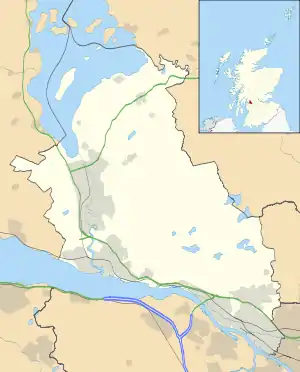 Dumbarton Castle | |
| Coordinates | 55.9360°N 4.5628°W |
| Site information | |
| Owner | Scottish Government[1][2] |
| Controlled by | Historic Environment Scotland |
| Open to the public | Yes |
| Site history | |
| Built | Site occupied since the Iron Age |
| In use | Still in use today |
History
According to the local museum, Dumbarton Rock is a volcanic plug of basalt created 334 million years ago, with the softer exterior of the volcano having weathered away.
Iron Age
At least as far back as the Iron Age, this has been the site of a strategically important settlement as evidenced by archaeological finds.
The people that came to reside there in the era of Roman Britain were known to have traded with the Romans - though these may or may not have been the Picts that dwelled in Dumbarton in the Bronze Age & early-mid Iron Age. However the first written record about a settlement there was marked in a letter Saint Patrick wrote to King Ceretic of Alt Clut in the late 5th century.
Early Medieval Era
David Nash Ford has proposed that Dumbarton was the Cair Brithon ("Fort of the Britons") listed by Nennius among the 28 cities of Sub-Roman Britain.[3] From the fifth century until the ninth, the castle was the centre of the independent Brythonic Kingdom of Strathclyde. Alt Clut or Alcluith (Scottish Gaelic: Alt Chluaidh, pronounced [aɫ̪d̪̊ˈxɫ̪uəj], lit. "Rock of the Clyde"), the Brythonic name for Dumbarton Rock, became a metonym for kingdom. The king of Dumbarton in about AD 570 was Riderch Hael, who features in Welsh and Latin works.
During his reign Merlin was said to have stayed at Alt Clut. The medieval Scalacronica of Sir Thomas Grey records the legend that "Arthur left Hoël of Brittany his nephew sick at Alcluit in Scotland."[4] Hoël made a full recovery, but was besieged in the castle by the Scots and Picts. The story first appeared in Geoffrey of Monmouth's Historia Regum Britanniae.[5] Amongst lists of three things, in the triads of the Red Book of Hergest, the third "Unrestrained Ravaging" was Aeddan Fradog (the Wily, perhaps Áedán mac Gabráin), coming to the court of Rhydderch the Generous at Alclud, who left neither food nor drink nor beast alive. This battle also appears in stories of Myrddin Wyllt, the Merlin of Geoffrey of Monmouth's Vita Merlini, perhaps conflated with the battle of Arfderydd, located as Arthuret by some authors.[6]
In 756, the first (and second) losses of Dumbarton Rock were recorded. A joint force of Picts and Northumbrians captured the fortress after a siege, only to lose it again a few days later. By 870, it was home to a tightly packed British settlement, which served as a fortress and as the capital of Alt Clut. In 871, the Irish-based Viking kings Amlaíb and Ímar laid siege to Dumbarton Rock. The fortress fell in four months, after its water supply failed. The kings are recorded to have returned to Ireland with 200 ships and a host of British, English, and Pictish captives. These prisoners may have included the ruling family of Alt Clut including the king Arthgal ap Dyfnwal, who was slain the following year under uncertain circumstances. Following the Viking destruction of the fortress, Dumbarton Rock does not appear on record again until the 13th century, and the capital of the restructured Kingdom of Strathclyde appears to have relocated up the Clyde to the vicinity of Partick and Govan.
Medieval Era
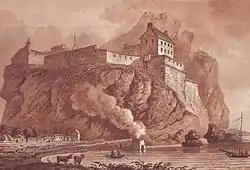
In medieval Scotland, Dumbarton (Dùn Breatainn, which means "the fortress of the Britons") was an important royal castle. It sheltered David II and his young wife, Joan of The Tower after the Scottish defeat at Halidon Hill in 1333.
In 1425 the castle was attacked by James the Fat, youngest son of Murdoch Stewart, Duke of Albany, who had been imprisoned by King James I of Scotland on charges of treason. James the Fat became a rallying point for enemies of the King, and raised a rebellion against the crown. He marched on the town of Dumbarton and burned it, but was unable to take the castle, whose defender John Colquhoun successfully held out against James' men.[8][9]
James IV and Dumbarton
The former supporters of James III under the leadership of John Stewart, 1st Earl of Lennox met up at Dumbarton Castle in October 1489. They had hoped to gain the support of Henry VII of England. James IV defeated them in a battle between the Touch and Menteith hills near Stirling on 11 and 12 October.[10] James IV used Dumbarton as the west coast base for his navy and campaigns to subdue the Western Isles. James was at Dumbarton with the Chancellor of Scotland, Colin Campbell, 1st Earl of Argyll, in November 1489. He had the use of a ship belonging to the Laird of Luss. In the following February a royal ship was 'chaysit' by the English and lost some of her cables. In 1494 a row barge was built at Dumbarton for the king using timber from Loch Lomond.
In March 1495 James IV was provided with a camp bed for use at sea and a boat carried cannon to Dumbarton. Patrick Hepburn, 1st Earl of Bothwell, was made Captain of the castle on 1 April 1495. A man played on the clarschaw, a Gaelic harp, for the King. In 1505 Dumbarton was the King's base for visiting the Western Isles. One ship's mast was made from timber from Drymen. On 5 June James was entertained by a French 'quhissilar', perhaps playing a recorder and on 8 June James played cards with John Murray and Master Robert Cockburn losing £4-10 shillings, and later that day attended Evensong in the Parish kirk and College of Dumbarton. In 1505 John Ramsay built a ship for the King called the Columb, ( Saint Columba being the father of Christianity in Scotland ). In December 1505 a sword that had belonged to William Wallace was repaired.[11]
Regent Albany, James V and the circumnavigation of Scotland
On 18 May 1515 the James or the Margaret with six other ships brought John Stewart, Regent Albany to Dumbarton. These royal ships were repaired at Dumbarton in July and new docks were made for them. John Drummond of Milnab brought fourteen of their guns to Glasgow.[12] In September Regent Albany held court at Dumbarton, and received Thomas Benolt, the English Clarenceux King of Arms. The Carrick Herald and Clarenceux were sent to Lord Maxwell.[13] In March 1516 Albany issued six letters of remission (forgiveness) to those who had held the castle for Lennox against the king in 1489.[14] Regent Albany returned to France from Dumbarton in 1524.[15]
In 1526 John Stewart, 3rd Earl of Lennox fortified Dumbarton against the Douglas faction who had control of the young James V, but his forces were defeated by Archibald Douglas, 6th Earl of Angus at the battle of Linlithgow Bridge. James Hamilton of Finnart, who was implicated in the death of the Earl of Lennox, was given custody of the castle till 1531.[16] Later in his personal reign James V used the castle as a prison for those convicted at the justice ayre, receiving their fines and composition payments in 1539.[17] In 1540 James circumnavigated Scotland from the Forth and arrived at Dumbarton with Cardinal Beaton, the Earl of Huntly, and the Earl of Arran each leading a force of five hundred men. This expedition was later published by Nicolas de Nicolay Seigneur d'Arfeville, cosmographer to the King of France in 1583, with the first modern map of Scotland's coastline.[18]
Lennox and Mary, Queen of Scots
Matthew, Earl of Lennox had been an ally of the French party in Scotland led by Mary of Guise but committed himself to the pro-English faction. In 1544 munitions and ten thousand French crowns of the sun arrived with Jacques de la Brosse at Dumbarton's harbour and were secured by Lennox and the Earl of Glencairn. Lennox then went into England, leaving the castle in the keeping of William Stirling of Glorat. Lennox signed a deal with Henry VIII of England offering Dumbarton Castle and the Isle of Bute in return for land in England and marriage to Henry's niece Margaret Douglas, and the future Governorship of Scotland if circumstances permitted. Lennox undertook to prevent the infant queen Mary being taken from Scotland. However, George Stirling of Glorat, unhappy at this policy, prevented Lennox returning into the castle and he was forced to sail to Ireland. George Stirling declared that he would hold the castle in the name of the young queen only. The Privy Council of Scotland agreed to George Stirling's plan. Despite this, more French troops landed at Dumbarton under the leadership of Lorges Montgomery, the soldier who later killed Henry II of France at a joust in 1559.[19]
In May 1545 Lennox tried to take the castle, with soldiers commanded by his brother, Robert Stewart, Bishop of Caithness. He had sailed from Chester with around 20 followers in May 1546 in the Katherine Goodman and a pinnace.[20] Regent Arran besieged the castle with a superior force, having borrowed the artillery of the Earl of Argyle. George Stirling of Glorat surrendered after 20 days and made terms. The chronicle historian John Lesley wrote that the Captain and the Bishop surrendered the castle to Arran and were rewarded, after negotiation by the Earl of Huntly.[21] The siege at Dumbarton delayed Arran's action at the siege of St Andrews Castle on the East coast of Scotland.[22] Thereafter the castle was in the hands of Regent Arran and he held court in person there in July giving legal remission to the keeper of the Castle and in March 1547 acknowledging the good service of George Stirling of Glorat in rendering the castle to him.[23]
As the war of the Rough Wooing continued, Mary, Queen of Scots was lodged in the castle by 22 February 1548. Alexander Cunningham, 5th Earl of Glencairn wrote to Mary of Guise from Dumbarton that he had received a French cargo, and it would be as safe as if it were in Stirling Castle.[24] The English commander Grey of Wilton proposed basing warships at Lamlash on Arran as a convenient base to watch for French ships coming for Mary.[25]
Mary of Guise was at the castle in the first days of May 1548 and Mary, Queen of Scots was kept at the castle for several months before her embarkation for France for safety on 13 July 1548. The sailing however was delayed by adverse winds till 7 August 1548. Her party including the Four Marys left the Clyde in a fleet under the command of Nicolas de Villegagnon. They sailed around the west coast of Ireland, to avoid English ships commanded by Edward Clinton.[26]
In France she was soon betrothed to the young dauphin Francis. Seven years after the end of the war of the Rough Wooing, in 1557, five hundred Gascon soldiers arrived at Dumbarton destined to serve on the borders against the English for Mary of Guise according to a rumour heard by Gilbert Kennedy, 3rd Earl of Cassilis.[27]
Marian Civil War, Regent Morton, and the Duke of Lennox
After the defeat at the battle of Langside John Fleming, 5th Lord Fleming, keeper of the Castle went with Queen Mary into England but was allowed to return. When William Kirkcaldy of Grange governor of Edinburgh Castle changed to support Mary, this became a problem for Regent Moray. The first siege was lifted because of the assassination of Regent Moray. The assassin James Hamilton of Bothwellhaugh was welcomed at the castle. Fleming's defence of Dumbarton for Mary was satirized in a ballad printed by Robert Lekprevik in May 1570; The tressoun of Dumbertane.[28] Attributed to Robert Sempill, the ballad describes Fleming's failed ambush of Sir William Drury in May 1570.[29] In October 1570 during the Marian civil war the castle was fortified for Mary against the supporters of James VI of Scotland with stones obtained by demolishing churches and houses in Dumbarton and Cardross.[30] The castle was captured by the forces of Regent Lennox led by Thomas Crawford of Jordanhill and John Cunningham of Drumquhassle in the early hours of 2 April 1571, who used ladders to scale the rock and surprise the garrison.[31]
Dumbarton Castle was used as prison for Regent Morton in June 1581 before his execution in Edinburgh. On 8 September 1582 the castle was put unto the keeping of Walter Stewart of Taberstoun an ally of Esmé Stewart, 1st Duke of Lennox, the King's favourite. The Duke of Lennox was displaced by the Gowrie Regime and went to the castle in secret pretending to be travelling from Edinburgh to nearby Dalkeith Palace. Lennox had his own ship there described as a barque. Robert Bowes, the English resident agent, expected the Duke of Lennox would sail to France from Dumbarton "having well victualled his shippe there." Other observers were anxious that the castle might become a foothold for French forces in Scotland allied to Lennox and his faction. In December 1582 two Englishmen in Lennox's service at Dumbarton left by his ship from Largs. Lennox himself travelled to France through England, never to return.[32]
Seventeenth century
Although few buildings remain from this period there are records of works in 1617, 1618, and 1628-9. A replacement Wallace Tower was built superseding the medieval building. In June 1618 masons were working on the upper storey and it was decided to make the tower larger. Externally it was finished with lime plaster called harling. At the south side there was a bell house. By 1627 it was discovered that the keeper Sir John Stewart of Methven had neglected the fortress. He was replaced by Sir John Stewart of Traquair who recorded the poor state of the building. Surviving accounts mostly record work on the artillery and the 'foir yet wall' a defence on the southern side. The Scottish Parliament in 1644 judged that the castle was likely to more hurtful than useful to the country.[33]
In November 1645 the Committee of Estates approved the recruitment of thirty extra soldiers by the keeper John Semple to guard the increased number of prisoners.[34] The castle's strategic importance declined after Oliver Cromwell's death in 1658. However, due to threats posed by Jacobites and the French in the eighteenth century, new structures and defences were built and the castle was garrisoned until World War II. Some documentation for these later works is preserved in the National Archives of Scotland.
Inventories
Several lists of the castle's contents survive, including inventories from 1510, 1571, 1580, 1644, and 1668. These list guns and furniture and name many locations in the castle.[35] There is also a list of cannon transported by John Drummond of Milnab to Dumbarton in 1536.[36] In 1510 St Patricks chapel contained an old parchment mass book, a pewter chalice, and liturgical cloths. The hall had four tables and next to that was a chalmer of Dess, a 'solar' in English terms with a bed. The Wallace tower was protected with an iron yett and draw bar, there were bedchambers within and a bell at the head of the tower; the 'Wynde Hall' contained another bed.[37]
In August 1536 George Stirling of Glorat took delivery from John Drummond the king's Master Wright of four great guns and six falcons on carriages with wheels, thirty three bronze hagbut hand-guns and four iron culverins, with ammunition and powder and ramrods for the big guns. John Drummond took away an old brass gun that was 10 feet (3 metres) long.[36]
In 1571 amongst the cannon and guns there was a "gross culverin", two small "batteris", and a French "moyen" mounted for use on the walls. Another moyen was suitable for action in the field. There were two Brittany-made falcons on the walls, a quarter falcon and a "double barse". Provisions included eleven hogshead of biscuit. Some of the guns were subsequently taken to besiege Edinburgh Castle during the Marian civil war.[38]
The document compiled in 1580 was "the inventar of the munitioun and uther insicht geir underwrittin left in the castell of Dumbertane be Johnne Conninghame of Drumquhassill and deliverit be the said Johnne to William Stewart of Cabirston in name and behalf of ane noble and potent lord Esme erll of Lennox lord Darnley and Obeigny on the 27 August 1580". There were six large cannon. The bed in the chamber of dais was now described as 'ane stand bed of eistland tymmar with ruf and pannell of the same', a bed made from imported Baltic oak.[39]
By 1644, when John Sempill was made keeper the 'Chamber of deisse' still contained a bed with a chamber pot and truckle bed for a servant, but it also contained armaments. There were twelve ram-rods, and three worms' - screws for unloading guns, three hagbuts and an iron flail. The hall contained twelve broken pikes, four without their iron blades. The contents of the armoury included thirty-three corslets, 105 helmets, and 43 swords.[40]
In 1668 the Governor Francis Montgomerie of Giffin recorded that the first floor of a lodging called the 'new chamber' contained 'a quantity of old rusty guns and sword, so rusted broke and spoiled that they can never serve for any use, above the beds were 'insufficient' and in the top room there was spoiled matches. The windows of this new lodging were broken. Montgomerie was worried about the water-supply from the loch and the 'laigh' low well.[41]
Governors and Keepers
Governors
- 1292: Sir Nicolas de Seagrave
- 1296 : Sir Ingram de Umfraville
- 1296 : Alexander de Ledes
- 1303 : Sir John de Menteith
- 1333 : Sir Malcolm Fleming of Cumbernauld
- 1357 : Sir Robert Erskine
- 1377 : Sir John Danyelstoun
- Sir Robert Danyelstoun
- 1400 : Walter de Danyelstoun (later bishop of St Andrews)
- 1424 : Sir John Colquhoun, 10th of Luss[42]
- John Cunningham, 11th Earl of Glencairn
- 1546- 1562 James Hamilton, Duke of Chatellerault, 2nd Earl of Arran[43]
- 1562: Robert Anstruther
- 1620: John Stewart of Methven
- 1633: Sir John Maxwell, 1st Baronet, of Pollok
- 1696: Francis Montgomerie
- 1715: William Cunningham, 12th Earl of Glencairn
- 1764: Archibald Montgomerie, 11th Earl of Eglinton
- 1782: Sir Charles Grey[44]
- 1797: Gerard Lake, 1st Viscount Lake[45]
- 1807: William Loftus
- 1810: Andrew John Drummond[46]
- 30 January 1817: Francis Dundas[47]
- 5 February 1824: George Harris, 1st Baron Harris[48]
- 22 May 1829: Thomas Graham, 1st Baron Lynedoch[49]
Lieutenant-Governors
- 1756: Charles Hubert Herriot[50]
- Campbell Edmonstone
- 1796: Hay Ferrier[51]
- 1799: Samuel Graham[52]
- Ferrier again?
- 15 April 1824: John Vincent[53]
Keepers
- 1425 Sir John Colquhoun, 10th of Luss[54]
- 1497 Sir John Striveling (Stirling) of Craigbernard [55]
- 1510 William Striveling (Stirling) 1st of Glorat (Son of Sir John Stirling) - Murdered Good Friday 1534)[56]
- 1534 George Striveling (Stirling) 2nd of Glorat (Son of William Stirling - Killed Battle of Pinkie 1547)[57]
- 1644 John Semple
- 22 December 1927: Sir George Murray Home Stirling, 9th Baronet of Glorat (10th Great-Grandson of Sir John Stirling above)[58]
- 4 July 1949: Alexander Patrick Drummond Telfer-Smollett[59]
- 9 May 1955: Sir Angus Edward Malise Bontine Cunninghame Graham[60]
- 12 June 1981: Alastair Stevenson Pearson[61]
- 10 September 1996: Donald David Graeme Hardie[62]
The castle today
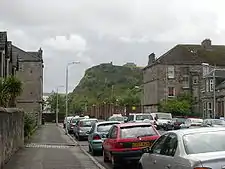
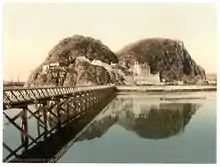
Today all visible traces of the Dark-Age Alt Clut, its buildings and defences, have gone. Not much survives from the medieval castle: the 14th-century Portcullis Arch, the foundations of the Wallace Tower, and what may be the foundations of the White Tower. There is a 16th-century guard house, which includes a face which according to legend is "Fause Menteith", who betrayed William Wallace.
Most of the existing structures were built in the 18th century, including the Governor's House, built for John Kennedy, 8th Earl of Cassilis, and fortifications which demonstrated the struggle by military engineers to adapt an intractable site to contemporary defensive needs. The splendid views from the twin summits of the White Tower Crag and the Beak remind us why this rocky outcrop was chosen as 'the fortress of the Britons' centuries ago.[63]
The castle is open on a daily basis during the summer season and Saturday-Wednesday in the winter. Visitors must climb the 557 steps to see the White Tower Crag and other features.
Dumbarton Rock is in state ownership and is legally protected by the Scottish Government as a Scheduled Ancient Monument,[64] to conserve it for future generations. Activities such as rock climbing are forbidden; any change or damage caused is considered a criminal offence.
Geodesy
Up to 1919 Dumbarton Rock was the origin (meridian) of the 6 inch and 1:2500 Ordnance Survey maps for Dumbartonshire. After that the maps for Dumbartonshire were drawn according to the meridian of Lanark Church Spire in Lanarkshire.[65]
Popular Culture
In 1803 Dorothy and William Wordsworth visited the castle and were told that a ruin on the top of the highest eminence had been a windmill and were shown a trout, boxed up in a well close by to the guard room, that had been there for thirty years.[66]
The castle features in The Scottish Chiefs.[67]
References
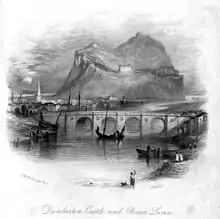
- http://www.scotlandnow.dailyrecord.co.uk/lifestyle/who-owns-scotlands-castles-take-7939278
- http://www.parliament.scot/S3_PublicPetitionsCommittee/Submissions_10/10-PE1352C.pdf
- Ford, David Nash. "[www.britannia.com/history/ebk/articles/nenniuscities.html The 28 Cities of Britain]" at Britannia. 2000.
- Leland, John, Collectanea, vol.1 part 2 (1770), p.510. John Leland's note of the Scalachronica: Sir Thomas Grey of Heton, Scalachronica, Edinburgh, (1836), p.318, French: "et lessa Hoel son neuew de la Peteit Bretaigne a Alclud en Escoz maladez."
- Schultz Albert, ed., Historia Regum Britanniae (1854), pp.125-6
- Ritson, J., Annals of the Caledonians, Picts, and Scots; and of Strathclyde, Cumberland, Galloway and Murray, (1828), pp.164-5, quoting Humphrey Llwyd
- Stoddart, John (1800), Remarks on Local Scenery and Manners in Scotland. Pub. Wiliam Miller, London. Facing P. 212.
- McAndrew, Bruce A., p.5, Scotland's Historic Heraldry Retrieved November 2010
- Campbell, Alastair, p. 113, A History of Clan Campbell, Volume 2 Retrieved November 2010
- N. MacDougall, James IV, (Tuckwell, East Linton, 1997), 172-3
- John Irving, Dumbarton Castle: its Place in the General History of Scotland (Bennett & Thomson Dumbarton 1917), pp. 21-24, quoting the Accounts of the Lord High Treasurer of Scotland.
- Accounts of the Lord High Treasurer of Scotland, vol. 5 (Edinburgh 1903), pp. xxxii-xxxiii
- Accounts of the Lord High Treasurer of Scotland, vol. 5 (Edinburgh 1903), pp. 223-4
- Register of the Privy Seal, vol. 1 (Edinburgh 1908) pp.419-420
- J. Irving, Dumbarton Castle, (1917), 29
- J. Irving, Dumbarton Castle, (1917), pp. 29-30
- Accounts of the Lord High Treasurer of Scotland, vol. 7 (Edinburgh), p. 282
- J. Irving, Dumbarton Castle, (1917), p. 30: | Nicolas D'Arfeville's map at the National Library of Scotland
- J. Irving, Dumbarton Castle (1917), pp. 31-34.
- Dasent, ed., Acts of the Privy Council, 1542-1547, vol. 1 (London, 1890), p. 379
- Thomson, Thomas, ed., John Lesley's History of Scotland (Bannatyne Club, 1830), 190.
- Accounts of the Lord High Treasurer of Scotland, vol. 8 (Edinburgh, 1908), lxxx, 453, 465: Letters & Papers Henry VIII, vol .21 part 2 (London, 1910) no. 6, Arran to the Pope.
- Register of the Privy Council of Scotland, vol.1 (Edinburgh 1877), pp. 34-5, 66-7.
- Annie Cameron, Scottish Correspondence of Mary of Lorraine (SHS: Edinburgh, 1927), pp. 36-7.
- Joseph Bain, Calendar State Papers Scotland: 1547-1563, vol. 1 (Edinburgh, 1898), p. 586
- J. Irving, Dumbarton Castle (1917), pp. 37-38.
- Accounts of the Lord High Treasurer of Scotland, vol. 10 (Edinburgh 1913) lxiii-xliv
- Calendar of State Papers Scotland, vol. 3, (1903), 177: The tressoun of Dumbarton, 15 May, Robert Lekprevik, Edinburgh, 1570.
- Cranstoun, James, Satirical Poems of the Reformation, vol. 1 (1892) 170-173, & notes vol. 2 (1893), 113-7.
- Calendar State Papers Scotland, vol. 3, (1903), 383.
- Lang, Andrew (1911). A History of Scotland. W. Blackwood in Edinburgh. pp. 64–68.
- Calendar of State Papers Scotland, vol. 6 (Edinburgh 1910), pp. 161, 168, 309: J. Irving, Dumbarton Castle, vol.1, (1917), 59-60: Bowes Correspondence, (London 1842), pp. 182, 188, 298-300
- J. Dunbar, ed, Accounts of the Masters of Works, vol.2 (HMSO Edinburgh 1982), pp. xciv xcvii
- D. Stevenson,Government of Scotland under the Covenanters, (SHS Edinburgh, 1982)34-5
- J. Irving, Dumbarton Castle, (Dumbarton 1917), pp.99-108: Thomas Thomson, ed., A Collection of Inventories, (Edinburgh 1815), pp.299-302: Register of the Privy Council of Scotland, vol. 3 (Edinburgh 1880), pp.319-320
- J. MacPhail ed., Papers from the Collection of William Fraser, (SHS, Edinburgh 1924), pp. 221-2
- J. Irving, Dumbarton Castle, (Dumbarton 1917), pp. 99-100
- J. Irving, Dumbarton Castle, (Dumbarton 1917), pp. 100-101
- Thomas Thomson, ed., A Collection of Inventories, (Edinburgh 1815), p.299
- J. Irving, Dumbarton Castle, (Dumbarton 1917), pp. 104 citing NLS Adv. Mss, Dennistoun
- J. Irving, Dumbarton Castle, (Dumbarton 1917), p. 107
- Fraser, William (1869). The chiefs of Colquhoun and their country;. Allen County Public Library Genealogy Center. Edinburgh [Printed by T. and A. Constable].
- Info board at Dumbarton Castle
- "No. 12333". The London Gazette. 21–24 September 1782. p. 2.
- "No. 14046". The London Gazette. 16–19 September 1797. p. 896.
- "No. 16396". The London Gazette. 14–18 August 1810. p. 1222.
- "No. 17217". The London Gazette. 11 February 1817. p. 300.
- "No. 18001". The London Gazette. 14 February 1824. p. 251.
- "No. 18588". The London Gazette. 26 June 1829. p. 1192.
- "No. 9599". The London Gazette. 10 July 1756. p. 1.
- "No. 13911". The London Gazette. 9 July 1796. p. 674.
- "No. 15199". The London Gazette. 29 October 1799. p. 1116.
- "No. 18021". The London Gazette. 24 April 1824. p. 661.
- Fraser, William (1869). The chiefs of Colquhoun and their country;. Allen County Public Library Genealogy Center. Edinburgh [Printed by T. and A. Constable].
- Albert Mach Sterling The Sterling (ed. Stirling) Genealogy (Grafton Press 1909) p.99-101
- J. Irving, Dumbarton Castle, (Dumbarton 1917), p. 99 Albert Mach Sterling The Sterling (ed. Stirling) Genealogy (Grafton Press 1909) p.99-101
- Albert Mach Sterling The Sterling (ed. Stirling) Genealogy (Grafton Press 1909) p.99-101.
- "No. 33340". The London Gazette. 23 December 1927. pp. 8243–8244.
- "No. 38660". The London Gazette. 8 July 1949. p. 3345.
- "No. 40475". The London Gazette. 10 May 1955. p. 2728.
- "No. 48669". The London Gazette. 3 July 1981. p. 8904.
- "No. 54546". The London Gazette. 8 October 1996. p. 13346.
- "Historic Scotland Official Souvenir Guide"
- Historic Environment Scotland. "Dumbarton Castle (SM90107)". Retrieved 2 April 2019.
- https://www.charlesclosesociety.org/files/153Meridians.pdf
- D. Wordsworth, p. 60-61
- Porter, Jane (1921). The Scottish Chiefs. New York: Charles Scribner's Sons. p. 123. ISBN 9780684193403.
Further reading
- John Irving, Dumbarton Castle, Its Place in the History of Scotland, (Dumbarton 1917)
- The correspondence of Robert Bowes, of Aske, esquire, the ambassador of Queen Elizabeth in the court of Scotland, Surtees Society (London 1842)
- Dorothy Wordsworth (1894). Recollections of a Tour Made in Scotland AD 1803. Edinburgh : David Douglas.
External links
- Historic Environment Scotland: Visitor guide
- Clyde Waterfront Heritage, Dumbarton Castle
- www.rampantscotland.com Dumbarton Castle
- Electric Scotland on the castle
- Map of Geoffrey of Monmouth's Britain, including Dumbarton, Siân Echard, University of British Columbia
- Engraving of Dumbarton Castle from the West in 1693 by John Slezer at National Library of Scotland